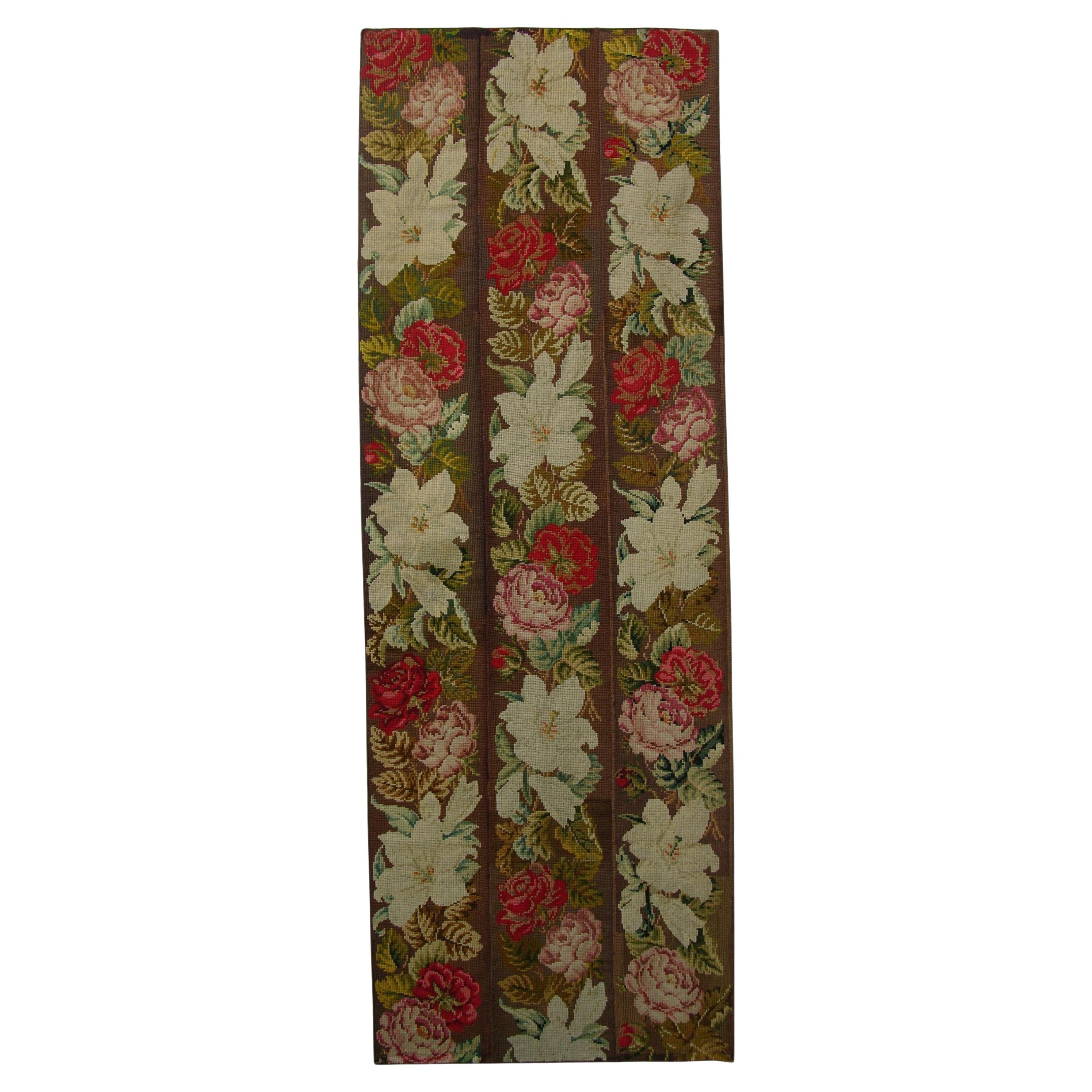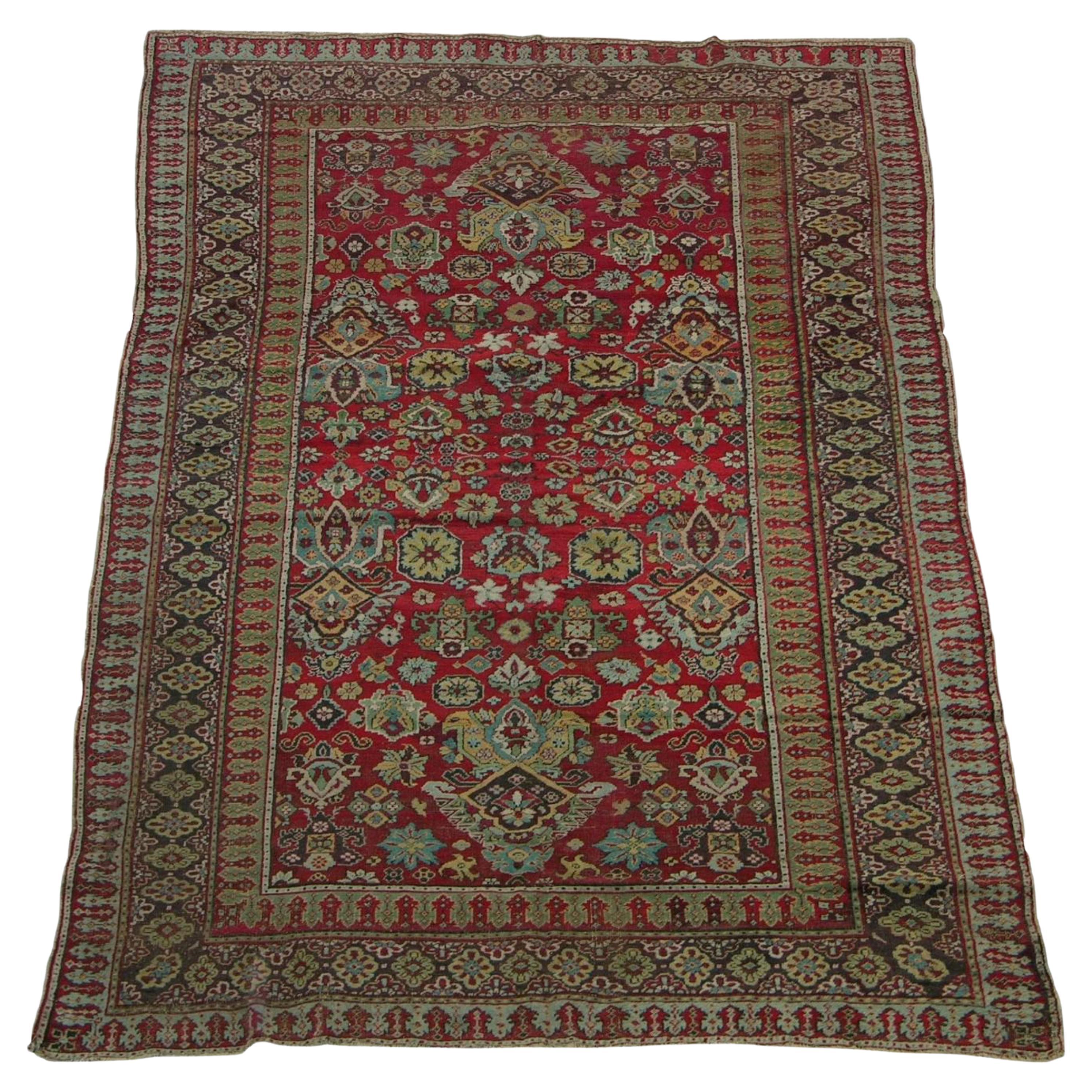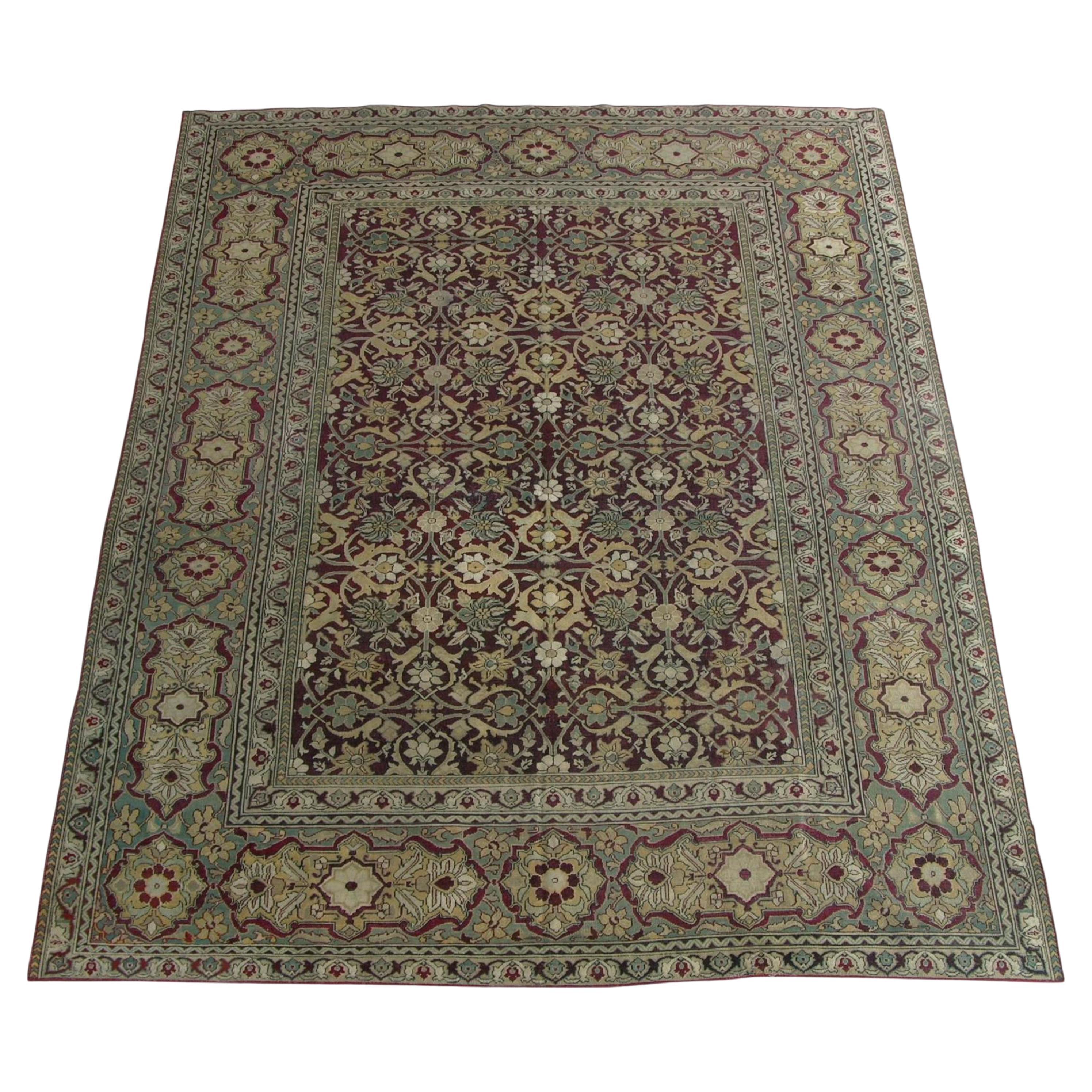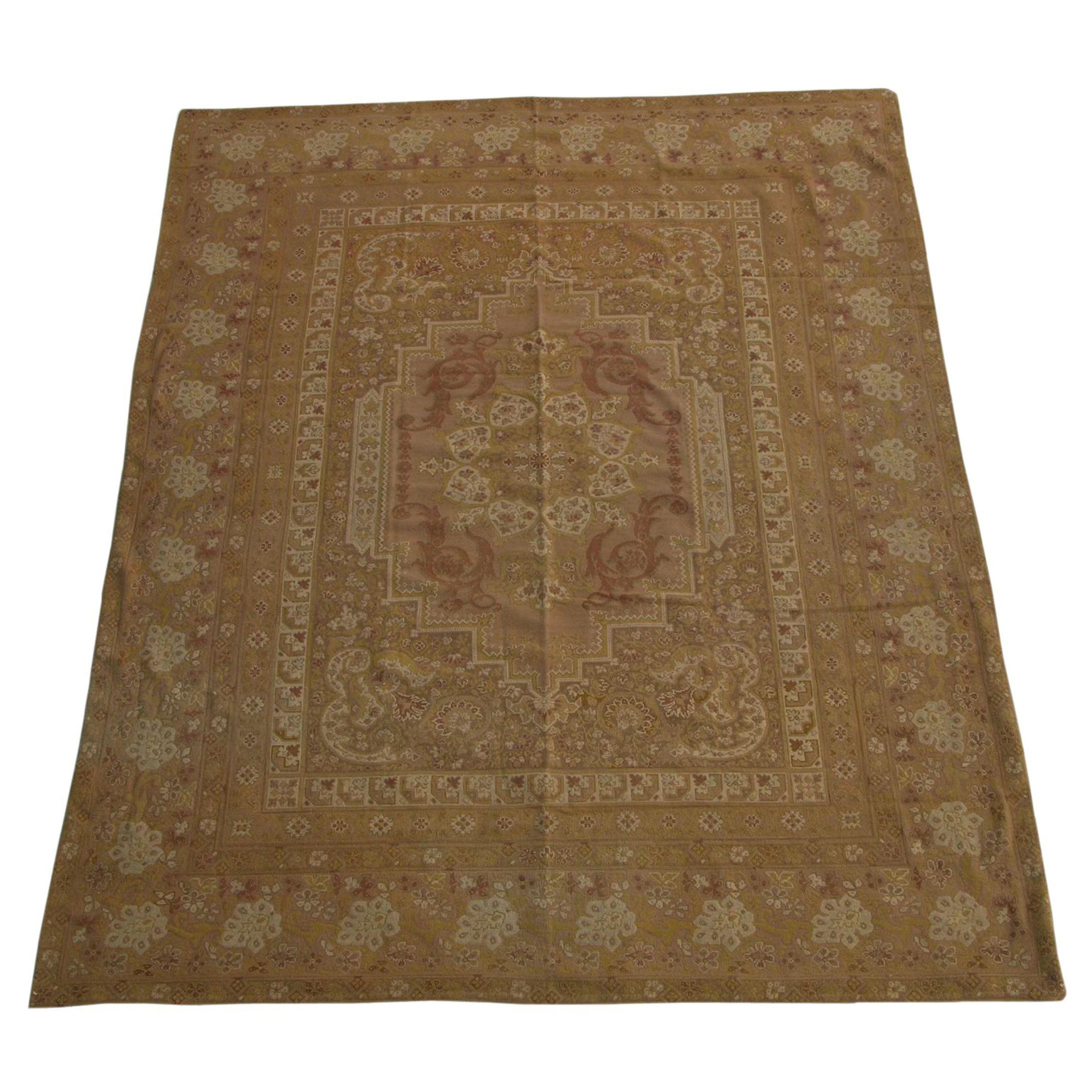Items Similar to 1900s Antique Floral Spanish Rug - 6'8'' X 5'0''
Want more images or videos?
Request additional images or videos from the seller
1900s Antique Floral Spanish Rug - 6'8'' X 5'0''
About the Item
Spanish Rugs – Although Spain is not generally thought of as a rug producing region, Spanish rugs represent the most venerable and honored tradition of rug production in Europe, going back to the time when much of Spain was part of the Islamic world. Still, the rugs woven in Spain were not Moorish products; native Spanish weavers had already learned the technique of making rugs by the fourteenth century, and they have continued to do so up to the twentieth century.
The antique Spanish rugs have a weave like no other pile rugs. These magnificent Spanish carpets are truly knotted, not looped, in staggered rather than superimposed rows. Their coloration has always been soft with dominant ivory grounds and pastel greens and yellows.
Although some early antique Spanish rugs imitated the designs and patterns of the antique Ottoman weavings, they soon developed a distinctive, uniquely Iberian or European style of vine scroll ornament. Early Spanish rug are highly desirable and coveted by collectors. This is contrast to the nineteenth and twentieth century Spanish made rugs which are sought after by consumers because they make excellent room size decorative rugs for many different home decorating aesthetics.
During the Islamic occupation, Spain was the first country in medieval Europe to make knotted pile rugs. Under the Islamic rules, the carpet weaving industry flourished from the 8th century through most of the 15th century.
The earliest existing Spanish carpets were woven during the 15th century and depict a multicultural lineage. Christian, Jewish, Muslim Arab and Berber populations co-existed for eight centuries and their combined artistic influence is reflected in their designs. By the 11th century, Spanish rugs were exported to the Orient, England and France.
Muslim and Christian princes and their courts admired and collected these magnificent antique Spanish rugs. By the 17th century, Spain’s economic depression coupled with the expulsion of Jews and Muslim artisans left the country artistically bankrupt. It was only with the help of rich patrons and the support of the monarchy, that the rug industry survived.
As a result, Spanish rug weaving followed the trends of France and England. They also followed the influences of the originality of diversity which gave way to a more Western and far more decorative approach.
- Dimensions:Width: 60 in (152.4 cm)Length: 80 in (203.2 cm)
- Style:Other (In the Style Of)
- Materials and Techniques:
- Period:1900-1909
- Date of Manufacture:1900
- Condition:Fair Condition.
- Seller Location:Los Angeles, US
- Reference Number:
About the Seller
5.0
Gold Seller
These expertly vetted sellers are highly rated and consistently exceed customer expectations.
Established in 1920
1stDibs seller since 2023
30 sales on 1stDibs
Typical response time: <1 hour
- ShippingRetrieving quote...Ships From: Los Angeles, US
- Return PolicyA return for this item may be initiated within 3 days of delivery.
More From This SellerView All
- 1900s Antique Needlework Floral DesignLocated in Los Angeles, USNeedlepoint rugs were created using the traditional needlework weaving technique that is used to make everyday items from furniture to carpets and artwork. However, it has a fascinat...Category
Antique Early 1900s Other Russian and Scandinavian Rugs
MaterialsWool, Cotton
- 1900s Antique Indian Amritsar RugLocated in Los Angeles, USAntique Amritsar Rugs: - The spectacular rugs of Amritsar capture the exotic style of India while incorporating a subtle colonial influence. This convergence of eastern and western s...Category
Antique Early 1900s Asian Other Russian and Scandinavian Rugs
MaterialsWool, Cotton
- 1900s Antique Indian Amritsar RugLocated in Los Angeles, USAntique Amritsar Rugs – The spectacular rugs of Amritsar capture the exotic style of India while incorporating a subtle colonial influence. This convergence of eastern and western styles results in an exceptionally alluring appearance that has been beloved by western consumers historically and today. The outstanding old Amritsar carpets were created by influential exporters to fuel the demand for exotic rugs...Category
Antique Early 1900s Asian Other Russian and Scandinavian Rugs
MaterialsWool, Cotton
- 1900s Antique French Needlepoint RugLocated in Los Angeles, USNeedlepoint rugs were created using the traditional needlework weaving technique that is used to make everyday items from furniture to carpets and artwork. However, it has a fascinating history both as a hobby and as an industry. When many people think of carpets, they think of pile carpets or flat weave kilims, but needlepoint has also been used to create beautiful carpets. These carpets are durable and an important part of carpet history. Archaeologists and scholars consider the roots of needlepoint to have been around 1500 BC. They consider the first needlepoint to include the fine diagonal stitches that were used to sew tents together by the ancient Egyptians. The art eventually evolved into tapestry weaving. However, a tapestry weaving differs significantly from needlepoint in that it uses a loom and vertical warp. Tapestry weaving is closer to the weaving of kilims and pile rugs than canvas work. However, some still include tapestry weaving in the category of needlepoint because of the fine work that appeared during the late Renaissance. It can have a similar appearance to the untrained eye. Technically, tapestry weaving and needlepoint are not the same, and they do not use the same technique. The first actual needlepoint rugs and needle-points began to appear in the late Renaissance. Needlepoint is worked by creating stitches on a stiff canvas. The canvas is typically made from jute or linen and is quite durable. Pieces from the Renaissance were used to cover footstools, chairs, pillows, bed headboards, and other furnishings. They were also used as table coverings and wall coverings. You could also find them on many small items such as purses, shoes, and various adornments for clothing. During the Renaissance, the craft reached a high level of skill, and the designs became incredibly detailed and realistic. They mimicked many of the subjects and styles of famous paintings of the time. They created florals, still life designs, scenes, and geometric tiled pieces. Some of them mimicked the designs found in Persian Carpets. Needlepoint reached its peak popularity in the 19th century when it was considered a proper occupation for a lady. Needlepoint and embroidery held a similar place in societal status at the time. During this time, the work became finer, with some of the canvas reaching a high level of detail. The level of detail is determined by counting the number of mesh in an inch. During this time petit point by French needlewomen could have a mesh count as high as 45 mesh. This allowed women to create highly intricate designs with incredible levels of detail. It is possible to find many antique pieces of needlepoint besides rugs. Needlepoint rugs were popular in France and Spain, where the technique was adapted to create highly intricate designs that mimicked the designs in architecture and fashion. They were popular because they were durable, and it could be fashioned into a variety of items. The canvases themselves were durable, and the wool that they used was also strong, which means that many of the pieces were able to withstand daily use. We have many artifacts that have survived from this time period. Needlepoint rugs are important collectibles because they are different from the pile rugs and kilims that are typically found on the market. Needlepoint carpets are special because they take many hours to create, especially larger works. Needlepoint pieces of any type became popular throughout Europe during the 19th century. It is still a popular hobby today, but perhaps one of the most interesting stories is that of the Portuguese needlewomen of Arraiolos. The story of these women and their beautiful carpets begins in 1492. Needlepoint was a popular occupation in Spain, which had a large population of Moors and Jews. They were an integral part of Spanish culture. However, in 1492, Queen Isabella of Spain issued a proclamation that gave these ethnic groups the order to pack their bags and board ships headed...Category
Antique Early 1900s Other Russian and Scandinavian Rugs
MaterialsWool, Cotton
- 1900s Antique Khotan Samarkand RugLocated in Los Angeles, USAntique Samarkand Rugs: The desert oasis of Khotan was an important stop on the Silk Road. The people of Khotan were expert carpet weavers who produced high quality antique rugs and ...Category
Antique Early 1900s Other Russian and Scandinavian Rugs
MaterialsWool, Cotton
- 1900s Authentic Tribal Floral Khotan RugLocated in Los Angeles, USAntique Samarkand Rugs: The desert oasis of Khotan was an important stop on the Silk Road. The people of Khotan were expert carpet weavers who produced high quality antique rugs and ...Category
Antique 19th Century Tribal Russian and Scandinavian Rugs
MaterialsWool, Cotton
You May Also Like
- Antique Khotan - Samarkand Rug 6'8 x 13'3Located in New York, NYAntique Khotan/Samarkand. 6'8x13'3. Antique Khotan/Samarkand rug from East Turkestan circa 1900. These decorative rugs are great accent pieces, using a great a balance of geometric a...Category
Antique 19th Century Russian Khotan Russian and Scandinavian Rugs
MaterialsWool
- Handmade Antique Caucasian Avar Rug, 1900s, 1p49Located in Bordeaux, FRHandmade antique Caucasian Avar rug from Daghetsan. The rug is in unusual design, from the beginning of 20th century. -condition: good, -circa: 1900s, ...Category
Antique Early 1900s Russian Russian and Scandinavian Rugs
MaterialsWool
- Antique Hand Woven Russian Besserabian Rug, circa 1900sLocated in New York, NYThis southern Russian kilim-tapestry technique carpet shows a golden-tan field with a three echelon pattern of outline cartouches and barbed leaf-forms detailed in sienna, cream and ...Category
Antique Early 1900s Russian Bessarabian Russian and Scandinavian Rugs
MaterialsWool
- Antique Russian Chichi, circa 1900sLocated in WEST HOLLYWOOD, CARug Number 17218 Size 3' 5" X 6' 2" Design Chichi Collection Antique/Vintage Material Wool Texture Pile Weave Origin Russia Age Antique/Vintage.Category
Antique Early 1900s Russian Russian and Scandinavian Rugs
MaterialsWool
- Antique Russian Gharabagh Circa 1900sLocated in WEST HOLLYWOOD, CARug Number 28430 Size 3' 8" X 5' 7" Design Gharabagh Collection Antique/Vintage Material Wool Texture Pile Weave Origin Russia Age Antique/VintageCategory
Antique Early 1900s Russian Russian and Scandinavian Rugs
MaterialsWool
- Rug Designed by Emma Salzman, Finland, Early 1900sBy Emma SalzmanLocated in Stockholm, SERug designed by Emma Salzman, Finland, early 1900's. Rya technique. Handwoven wool. Measurements: H: 349 cm/ 11' 5 7/16" W. 185 cm/ 6 26/32"Category
Antique Early 1900s Finnish Scandinavian Modern Russian and Scandinavian...
MaterialsWool





